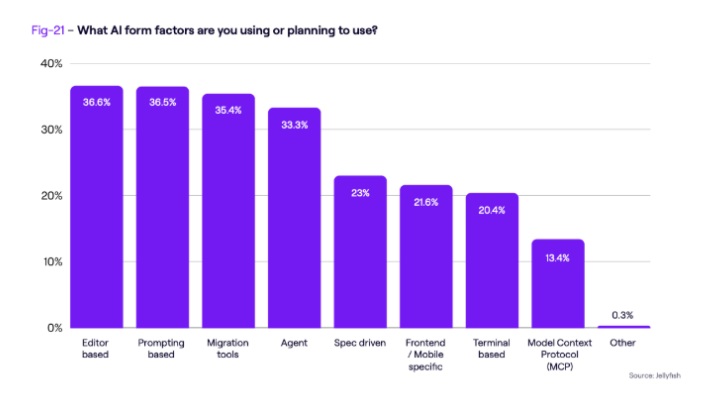Only 2% of teams are using AI agents — that’s your advantage.
Learn how to implement the right agent for the right task
Engineering orgs are racing to adopt AI. Over 90% of engineering teams now use some form of AI coding tool — up from just 61% last year.
Meanwhile, only 2% of those teams have fully scaled AI agents into production.
That stat doesn’t signal hesitation — it signals a gap. Not just in skills, but in tooling maturity, operational readiness, and organizational confidence.
Agents have a long way to go. Regardless, they are the next wave of development. And I believe agents will revolutionize development in the next 5 years.
Developers who start using them now will be first in line when agent-powered development goes from experimental to essential.
Today, I’m going to walk you through:
What exactly an agent is (what they can do and where they still fall short)
The most common ways devs are implementing AI agents into their workflows today
The best way to actually get hands-on with AI agents
Coding Agents 101
Before we get too technical, let’s get the basics out of the way.
An AI coding agent is an LLM‑powered worker that can plan and act on your codebase using the same tools as you would — whether that’s via an editor, terminal, browser, CI job, or API call.
It’s more sophisticated than autocomplete, but far less than a fully autonomous engineer.
As a developer, you can delegate routine tasks to AI agents, like:
Task automation: Agents can handle repetitive tasks, like summarizing meetings or managing workflows.
Code assistance: They can debug, refactor, and even optimize your code autonomously
Documentation & onboarding: Agents can generate (and keep updated) README files, API reference snippets, or even short “how-to” videos, so new teammates ramp up without you writing a single wiki page.
These are just a few rudimentary examples of AI agent applications. And there are various types of agents you can lean into depending on your specific use case.
Many forms, many functions
In May, GitHub released its latest coding agent to its Enterprise and Pro+ users: GitHub Copilot Coding Agent.
This asynchronous coding agent is embedded directly into the platform and is accessible from VS Code — creating an Agentic DevOps loop across the world’s most widely adopted coding environments. Here’s what some industry leaders had to say about it:
“The GitHub Copilot coding agent fits into our existing workflow and converts specifications to production code in minutes. This increases our velocity and enables our team to channel their energy toward higher-level creative work.” Alex Devkar, Senior Vice President, Engineering and Analytics, Carvana
“The Copilot coding agent is opening up doors for human developers to have their own agent-driven team, all working in parallel to amplify their work. We’re now able to assign tasks that would typically detract from deeper, more complex work — allowing developers to focus on high-value coding tasks.” James Zabinski, DevEx Lead at EY
A few weeks later, Amazon unveiled its latest agentic coding offering: AWS Kiro. As a spec-driven fork of VS Code, Kiro turns plain-English requirements into runnable code and “works alongside devs from prototype or production.”
(The Kiro team actually released a really cool interactive tutorial that showcases what it’s capable of. You can find that here.)
While they share a high degree of underlying hype, these latest examples to hit the AI coding market actually represent two pretty different schools of thought in terms of actual implementation.
This graph from Jellyfish’s recent report on which AI form factors engineering teams are currently using helps paint the picture:
Press enter or click to view the image in full size
Clearly, there’s a lot of different ways to leverage this new technology.
But in my opinion, you should be familiar with two primary implementation styles:
Editor agents (like GitHub Copilot Coding Agent)
Pipeline/headless agents (like AWS Kiro)
Editor agents are great for tight feedback loops: they sit in your IDE, respond in seconds, and keep you in control of every change. They shine on small refactors, test generation, and docs cleanup, but their impact is capped by whatever context you remember to feed them.
Pipeline/headless agents are built for scale. These run as part of CI/CD or scheduled jobs and can sweep across repos to enforce standards, migrate code, or update infra. They require stronger guardrails and clearer specs up front, but pay off when you need consistent, repeatable changes without babysitting every prompt.
Keep this table in your back pocket for when you need to determine what use case is best for your task at hand:
Press enter or click to view the image in full size
The best way to actually get hands-on with AI agents
An agentic future requires devs with these skills:
Task planning and prioritization
Multi-agent coordination
Optimization strategies
API and tool development
But for now, I’d say to pick one agentic tool to start familiarizing yourself with.
Next week, you can expect a detailed roadmap on how to get started with the AI skills you need to master in order to stay relevant.
And if you have some extra time, this course on Multi-Agent Systems is a great place to start wrapping your head around the potential and promise of agentic AI.
Happy learning!
- Fahim





